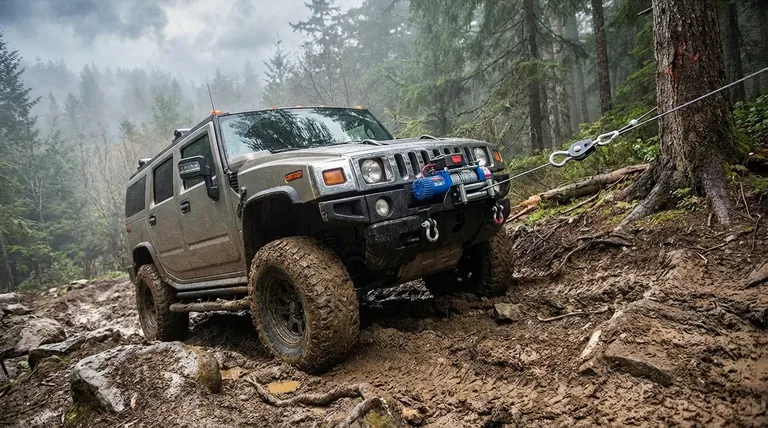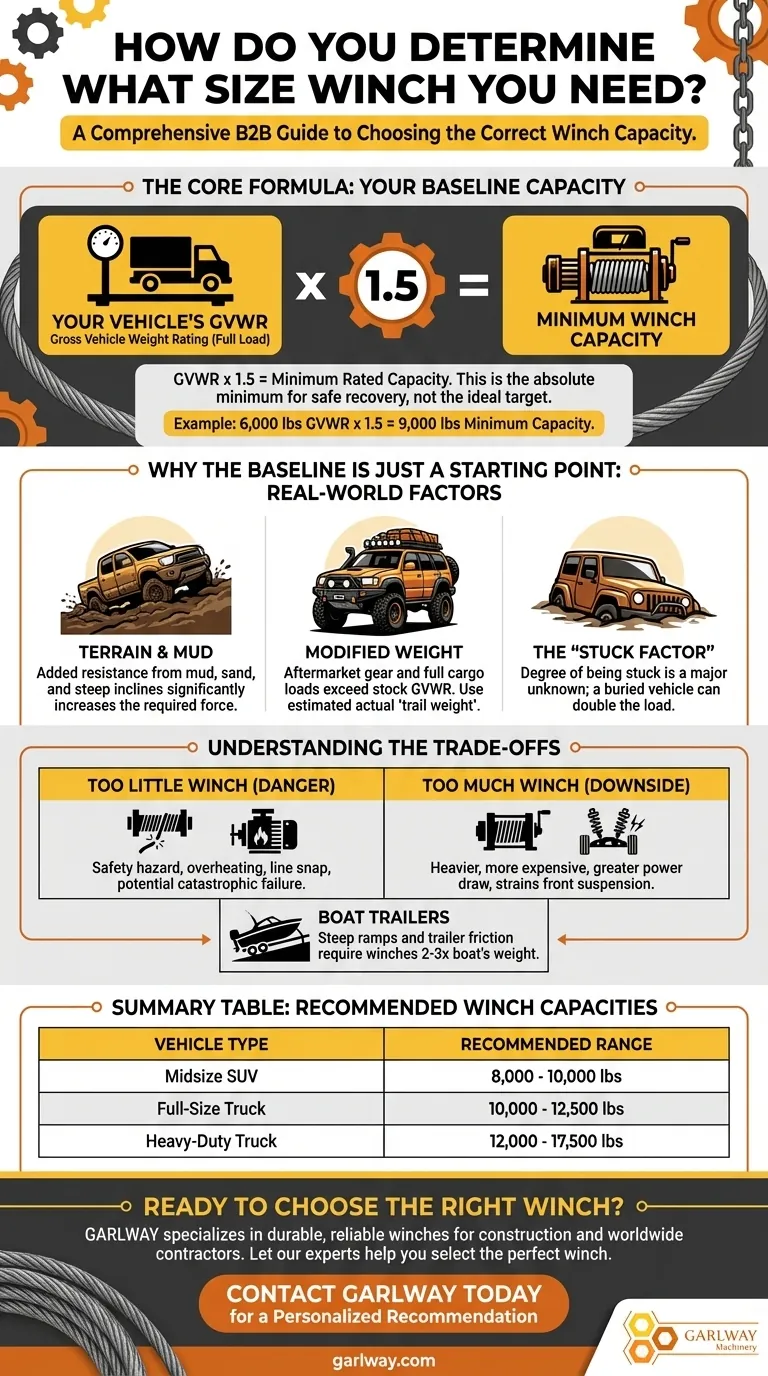To determine the right winch size, you must calculate a baseline capacity and then adjust for real-world factors. The universally accepted starting point is to take your vehicle's Gross Vehicle Weight Rating (GVWR) and multiply it by 1.5. This calculation provides the minimum rated capacity you should consider for safe and effective recovery operations.
The core principle is that the standard "GVWR x 1.5" formula is only a baseline. Real-world resistance from mud, inclines, and added vehicle weight requires you to treat this number as the absolute minimum, not the ideal target.

The Core Formula: Understanding the Baseline
The foundation of any winch calculation is understanding your vehicle's weight and the forces at play.
First, Find Your GVWR
The Gross Vehicle Weight Rating (GVWR) is the maximum safe operating weight of your vehicle, including the chassis, body, engine, fuel, passengers, and cargo. It is not the vehicle's curb weight.
You can find your vehicle's GVWR on the compliance sticker, typically located on the driver-side door jamb or in your owner's manual.
Apply the 1.5 Multiplier
The 1.5 multiplier is the industry standard for a reason. It accounts for the additional force, or "suck," required to overcome resistance that isn't present when a vehicle is just rolling freely.
For example, if your truck's GVWR is 6,000 lbs, your minimum winch capacity is 6,000 lbs x 1.5 = 9,000 lbs. You should look for a winch with a rated capacity of 9,000 lbs or more.
Why the Baseline Is Just a Starting Point
A simple calculation doesn't account for the challenging variables of an actual recovery situation. This is where critical thinking is essential.
The Impact of Terrain
A vehicle stuck deep in mud or sand requires significantly more force to extract than one sitting on level, hard-packed dirt.
Steep inclines are a massive force multiplier. The pull required to move a vehicle up a hill is far greater than what's needed on flat ground.
Accounting for Actual Loaded Weight
The GVWR is for a stock vehicle. Aftermarket bumpers, larger tires, roof racks, and heavy gear add hundreds of pounds.
For heavily modified vehicles, it's wiser to estimate your actual "trail weight" and use that figure in your calculation for a more realistic capacity requirement.
The "Stuck Factor"
The degree to which a vehicle is stuck is the biggest unknown. A vehicle high-centered on a rock or buried to its frame in mud can effectively double the load on the winch. The 1.5 multiplier provides a safety buffer for these common scenarios.
Understanding the Trade-offs
Choosing a winch isn't just about picking the biggest number; it's about finding the right balance for your specific needs.
The Danger of "Too Little" Winch
An undersized winch is a serious safety hazard. Overloading it can lead to overheating the motor, snapping the line, or catastrophic failure of the winch or its mounting points. This puts you and your vehicle at significant risk.
The Downside of "Too Much" Winch
While a larger capacity offers more peace of mind, it comes with penalties. A significantly oversized winch is heavier, putting more strain on your front suspension. It also costs more and can demand more power than your vehicle's electrical system can comfortably provide.
A Note on Boat Trailers
Winching a boat onto a trailer is a different application. The calculation must account for the boat's total weight (with fuel and gear), the ramp's steepness, and the friction of the trailer bunks versus rollers. For steep ramps, a winch with a capacity of two or even three times the boat's weight may be necessary.
Making the Right Choice for Your Goal
Use the baseline formula as your foundation and adjust based on your intended use.
- If your primary focus is a stock vehicle for light trails: The standard 1.5 x GVWR formula is a reliable and safe guide.
- If your primary focus is a modified rig for extreme off-roading: Use your vehicle's fully loaded trail weight (not just GVWR) as the base and consider the 1.5x multiplier the absolute minimum.
- If your primary focus is safety and peace of mind: Selecting a winch with a capacity of 10,000-12,500 lbs covers the vast majority of full-size trucks and SUVs in almost any situation.
Ultimately, selecting the correct winch is an investment in your safety and capability.
Summary Table:
| Vehicle Type | Typical GVWR | Minimum Winch Capacity (GVWR x 1.5) | Recommended Range |
|---|---|---|---|
| Midsize SUV | 5,500 - 6,500 lbs | 8,250 - 9,750 lbs | 8,000 - 10,000 lbs |
| Full-Size Truck | 7,000 - 10,000 lbs | 10,500 - 15,000 lbs | 10,000 - 12,500 lbs |
| Heavy-Duty Truck | 10,000+ lbs | 15,000+ lbs | 12,000 - 17,500 lbs |
Ready to choose the right winch for your vehicle?
An undersized winch is a safety risk, while an oversized one adds unnecessary weight and cost. GARLWAY specializes in durable, reliable winches for construction companies and contractors worldwide. Our experts can help you select the perfect winch based on your specific vehicle and recovery needs.
Contact GARLWAY today for a personalized recommendation and ensure your next recovery is safe and successful!
Visual Guide

Related Products
- Electric and Hydraulic Winch for Heavy Duty Applications
- Warn Winch Windlass Boat Trailer Winch
- Electric 120V Boat Winch by Badlands
- Best 18000 Pound Drum Anchor Trailer Winch
- 12000 lb Heavy Duty Electric Boat Winch
People Also Ask
- How do I choose an electric winch? A guide to safe and effective pulling power.
- How long can you run an electric winch? Master Safe, Efficient Vehicle Recovery
- What is the difference between electric winch and electric hoist? Essential Safety & Application Guide
- How does the electric winch work? Unlock the Power of Force Multiplication
- How to maintain an electric winch? Ensure Peak Performance & Reliability for Your Projects



















